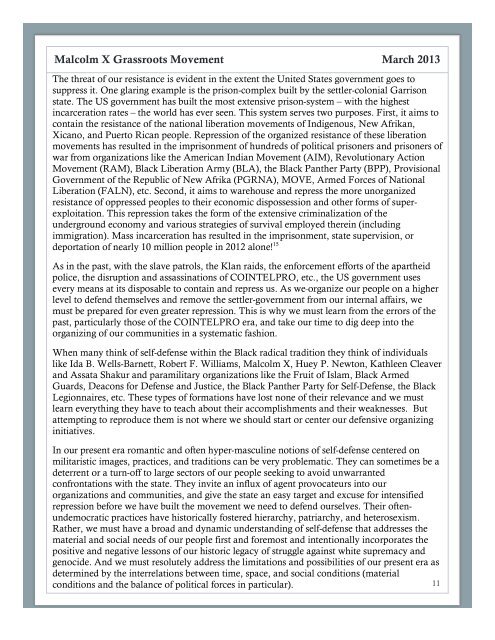MXGM Self-Defence Manual
MXGM Self-Defence Manual
MXGM Self-Defence Manual
You also want an ePaper? Increase the reach of your titles
YUMPU automatically turns print PDFs into web optimized ePapers that Google loves.
;<br />
Malcolm X Grassroots Movement March 2013<br />
The threat of our resistance is evident in the extent the United States government goes to<br />
suppress it. One glaring example is the prison-complex built by the settler-colonial Garrison<br />
state. The US government has built the most extensive prison-system – with the highest<br />
incarceration rates – the world has ever seen. This system serves two purposes. First, it aims to<br />
contain the resistance of the national liberation movements of Indigenous, New Afrikan,<br />
Xicano, and Puerto Rican people. Repression of the organized resistance of these liberation<br />
movements has resulted in the imprisonment of hundreds of political prisoners and prisoners of<br />
war from organizations like the American Indian Movement (AIM), Revolutionary Action<br />
Movement (RAM), Black Liberation Army (BLA), the Black Panther Party (BPP), Provisional<br />
Government of the Republic of New Afrika (PGRNA), MOVE, Armed Forces of National<br />
Liberation (FALN), etc. Second, it aims to warehouse and repress the more unorganized<br />
resistance of oppressed peoples to their economic dispossession and other forms of superexploitation.<br />
This repression takes the form of the extensive criminalization of the<br />
underground economy and various strategies of survival employed therein (including<br />
immigration). Mass incarceration has resulted in the imprisonment, state supervision, or<br />
deportation of nearly 10 million people in 2012 alone! 15<br />
As in the past, with the slave patrols, the Klan raids, the enforcement efforts of the apartheid<br />
police, the disruption and assassinations of COINTELPRO, etc., the US government uses<br />
every means at its disposable to contain and repress us. As we organize our people on a higher<br />
level to defend themselves and remove the settler-government from our internal affairs, we<br />
must be prepared for even greater repression. This is why we must learn from the errors of the<br />
past, particularly those of the COINTELPRO era, and take our time to dig deep into the<br />
organizing of our communities in a systematic fashion.<br />
When many think of self-defense within the Black radical tradition they think of individuals<br />
like Ida B. Wells-Barnett, Robert F. Williams, Malcolm X, Huey P. Newton, Kathleen Cleaver<br />
and Assata Shakur and paramilitary organizations like the Fruit of Islam, Black Armed<br />
Guards, Deacons for Defense and Justice, the Black Panther Party for <strong>Self</strong>-Defense, the Black<br />
Legionnaires, etc. These types of formations have lost none of their relevance and we must<br />
learn everything they have to teach about their accomplishments and their weaknesses. But<br />
attempting to reproduce them is not where we should start or center our defensive organizing<br />
initiatives.<br />
In our present era romantic and often hyper-masculine notions of self-defense centered on<br />
militaristic images, practices, and traditions can be very problematic. They can sometimes be a<br />
deterrent or a turn-off to large sectors of our people seeking to avoid unwarranted<br />
confrontations with the state. They invite an influx of agent provocateurs into our<br />
organizations and communities, and give the state an easy target and excuse for intensified<br />
repression before we have built the movement we need to defend ourselves. Their oftenundemocratic<br />
practices have historically fostered hierarchy, patriarchy, and heterosexism.<br />
Rather, we must have a broad and dynamic understanding of self-defense that addresses the<br />
material and social needs of our people first and foremost and intentionally incorporates the<br />
positive and negative lessons of our historic legacy of struggle against white supremacy and<br />
genocide. And we must resolutely address the limitations and possibilities of our present era as<br />
determined by the interrelations between time, space, and social conditions (material<br />
conditions and the balance of political forces in particular).<br />
11


